Foreword by your authors
The very name of the city evokes a tapestry of memories for Misho and me. Nestled in the heart of the Balkans, this city is where history, culture, and nature converge in a mesmerizing dance. On our first visit, we were drawn to the Baščaršija, Sarajevo’s old bazaar and the historical and cultural center of the city.
As we meandered through its narrow alleyways, the aroma of freshly brewed coffee wafted through the air, leading us to a quaint little café. Settling down with our cups of traditional Bosnian coffee, we struck up a conversation with an elderly local named Adem. With a twinkle in his eye, he began recounting tales of Sarajevo’s rich past, from the Ottoman era to the Austro-Hungarian influence, and the resilience of its people during the siege.
But it was his personal story of a long-lost love during the war that left an indelible mark on our hearts. As the sun set, casting a golden hue over the city, Adem’s narrative reminded us that Sarajevo, with its scars and stories, is a testament to the enduring spirit of humanity.
For Misho and me, Sarajevo isn’t just a destination; it’s a journey through time, filled with tales waiting to be discovered.
Quick Intro
Situated in the heart of the Balkans, Sarajevo is one of Europe’s most cultural and diverse cities. From its rich history to its vibrant present, Sarajevo is a city that has something for everyone.
Spanning over 1,000 years, Sarajevo has seen empires come and go while still maintaining its unique culture throughout the ages. It is a prominent cultural hub and has been a center of cultural, educational, political, economic, and religious activity for centuries.
Sarajevo is one of the most diverse cities in Europe, with a population that includes Muslims, Jews, Christians, Catholics, Orthodox Christians, and other religions.
So, whether you’re here for the food, culture or history, you’ll find it and more!
Before we see what are the best things to do in Sarajevo let’s check off some basics ok?
10 Tips For Tourists Visiting Sarajevo
A city of stories, resilience, and rich culture. If you’re planning a trip, Misho and I have some tips from our adventures that might come in handy:
- Historical Significance: Take the time to understand Sarajevo’s complex history. Visit the Sarajevo Tunnel Museum and the spot where Archduke Franz Ferdinand was assassinated, triggering World War I.
- Baščaršija: This old bazaar is the heart of Sarajevo. Wander its cobbled streets, visit the mosques, and don’t forget to sip on traditional Bosnian coffee at one of the many cafes.
- Local Cuisine: Try “ćevapi” (grilled minced meat), “burek”, and “sogan-dolma” (stuffed onions). Misho is particularly fond of “tufahija”, a walnut-stuffed apple dessert.
- Trams: Sarajevo’s tram system is one of the oldest in Europe. It’s an affordable way to get around, but remember to buy and validate your ticket to avoid fines.
- Diverse Religions: In a short walk, you can see mosques, churches, and synagogues. Respect local customs, especially when entering places of worship.
- Sarajevo Roses: You might notice red patterns on the ground. These are memorials to the places where mortar shells killed civilians during the siege. It’s a somber reminder of the city’s past.
- Safety: Sarajevo is generally safe for tourists. However, if you venture into the countryside, be cautious of unexploded landmines from the war. Stick to marked paths.
- Mountain Adventures: If you’re visiting in winter, the nearby mountains like Jahorina offer excellent skiing. In summer, they’re great for hiking.
- Festivals: Sarajevo hosts various festivals, from film to jazz. Check the local calendar to see if your visit aligns with any.
- Warm Hospitality: Bosnians are known for their warmth and hospitality. Don’t be surprised if locals strike up a conversation or invite you for a coffee.
Sarajevo is a city where east meets west, and history meets the present. Embrace its spirit, and you’ll leave with stories and memories, just like the ones Misho and I cherish. Safe travels!
How to get to Sarajevo?
Here’s a rundown of the most common ways to reach this captivating city:
- By Air:
- Sarajevo International Airport (SJJ) is the main gateway to the city. It’s located around 12 kilometers southwest of the city center. Several airlines operate flights connecting Sarajevo to major European cities.
- Once you land, you can take a taxi or a shuttle bus to reach the city center.
- By Train:
- Sarajevo’s railway station connects it to other major cities in Bosnia and Herzegovina, as well as international destinations. The train journey offers scenic views, especially if you’re coming from Mostar.
- The station is located a bit southeast of the city center, but it’s easily accessible by public transport or taxi.
- By Bus:
- The main bus station is adjacent to the train station. Buses are a popular mode of transport in the Balkans, and Sarajevo is well-connected to cities both within Bosnia and Herzegovina and neighboring countries.
- Several bus companies operate daily routes, and tickets can be purchased online, at the station, or directly from the bus driver.
- By Car:
- If you’re feeling adventurous like Misho and me, you can rent a car and drive to Sarajevo. The city is connected by well-maintained roads, but be prepared for mountainous terrains and winding routes.
- Ensure you’re familiar with local driving regulations, and always have your international driving permit, passport, and vehicle documentation on hand.
- By Bike:
- For the truly intrepid traveler, cycling to Sarajevo can be an unforgettable experience. The city is part of the EuroVelo 8 route, which runs along the Mediterranean. However, this is a challenging journey given the region’s mountainous terrain, so it’s best suited for experienced cyclists.
Remember, no matter how you choose to get to Sarajevo, the journey is as much a part of the adventure as the destination itself. Safe travels, and perhaps we’ll bump into you in one of Sarajevo’s charming cafes!
Best Time To Visit Sarajevo
Misho and I have experienced the city in all its seasonal splendors. Here’s our take on the best times to explore this historical gem:
- Spring (April to June): Spring is a delightful time to visit Sarajevo. The city awakens from its winter slumber, with blossoms adorning the streets and parks. The temperatures are mild, making it perfect for sightseeing and outdoor activities. Plus, the tourist crowds are still thin, offering a more intimate experience.
- Summer (July to August): Summers in Sarajevo are warm but not scorching. This is the peak tourist season, with various festivals and events taking place, such as the renowned Sarajevo Film Festival. The evenings are particularly lively, with locals and tourists alike enjoying the city’s vibrant café culture. However, be prepared for occasional rain showers.
- Autumn (September to November): Autumn is Misho’s favorite time in Sarajevo. The city is painted in hues of gold and crimson, and there’s a crispness in the air. It’s an excellent time for hiking in the nearby mountains and enjoying the local harvest, especially the grapes and plums. The tourist crowds also start to thin out, making it a more relaxed time to explore.
- Winter (December to February): If you’re a fan of winter sports, this is the time to visit. The nearby mountains, like Jahorina and Bjelašnica, offer excellent skiing and snowboarding opportunities. Sarajevo itself gets a magical, snowy blanket, and the festive season brings a special charm to the city. However, be prepared for colder temperatures and pack accordingly.
In essence, Sarajevo has something unique to offer in every season. Whether you’re sipping coffee in a sunlit square, wandering through autumnal parks, or enjoying the winter festivities, the city’s spirit shines through. Just pack accordingly, and maybe Misho and I will see you there, sharing tales of our Balkan adventures!
Alright, time to delve into each of the most important things to do in Sarajevo!
Sarajevo`s Old Town

What is it?
Sarajevo’s Old Town is a vibrant neighborhood packed with fascinating history and culture. Set against the backdrop of the Dinaric Alps, this area is known for its winding streets, Ottoman-era architecture, and bustling atmosphere. As one of the oldest parts of the city, it has seen many changes over time but still remains a popular destination for both locals and tourists alike.
The Old Town has been a part of Sarajevo since its formation in 1450 by Isa-Beg Isakovic, who was also responsible for laying out the city as we know it today. The neighborhood features iconic landmarks such as Sebilj Fountain and Gazi Husrev Mosque which are iconic symbols representing Bosnian identity.
This tour will take you on a trip around the old city and more!
Brief history
Sarajevo Old Town, also known as Bascarsija or Stari Grad, is the historical and cultural center of the city of Sarajevo.
The cobblestone streets and old wooden houses make up an enchanting atmosphere that visitors will never forget. There are plenty of fascinating sights and attractions such as Coppersmiths’ Street, and Latin Bridge where Franz Ferdinand was assassinated in 1914. This incident sparked World War I which would later shape modern European geography.
Latin Bridge Of Sarajevo

BA, Obala Kulina bana bb, Sarajevo 71000, Bosnia & Herzegovina || open 24 hours
What is it?
The Latin Bridge of Sarajevo is an iconic landmark in the city, a symbol of tolerance and multiculturalism. Located in the old quarter of the Bosnian capital, this bridge connects two religions and cultures that have been at odds for centuries: Islam and Christianity.
Built in 1565 by Ottoman Sultan Suleiman I, it was originally known as Ćumurija Bridge until 1878 when it was renamed Latin Bridge during the Austro-Hungarian occupation. This decision reflected the heavy presence of Catholic people in Sarajevo at the time, who were known as Latins due to their use of the Latin language.
Brief history?
Today, however, this bridge serves to unite rather than divide those who cross it. It stands as a reminder that despite our differences we can coexist peacefully and accept one another for who we are.
The Latin bridge of Sarajevo is a historic structure that has long been a symbol of the city. It is located at the intersection of two major rivers. The bridge itself is named for its builder, Mimar Hajrudin, who was known as “the Latin architect” because he was from Italy.
3 fun facts about the Latin bridge of Sarajevo
- The Latin bridge of Sarajevo is one of the most iconic landmarks in the city, a symbol of different cultures and history.
- The Latin bridge was originally known as Ćumurija Bridge after Mehmed Paša Ćumurija who had ordered its construction.
- Its current name was given during Austrio-Hungarian rule when they erected four plaques depicting Latin inscriptions which still stand proudly today.
The City Hall Of Sarajevo
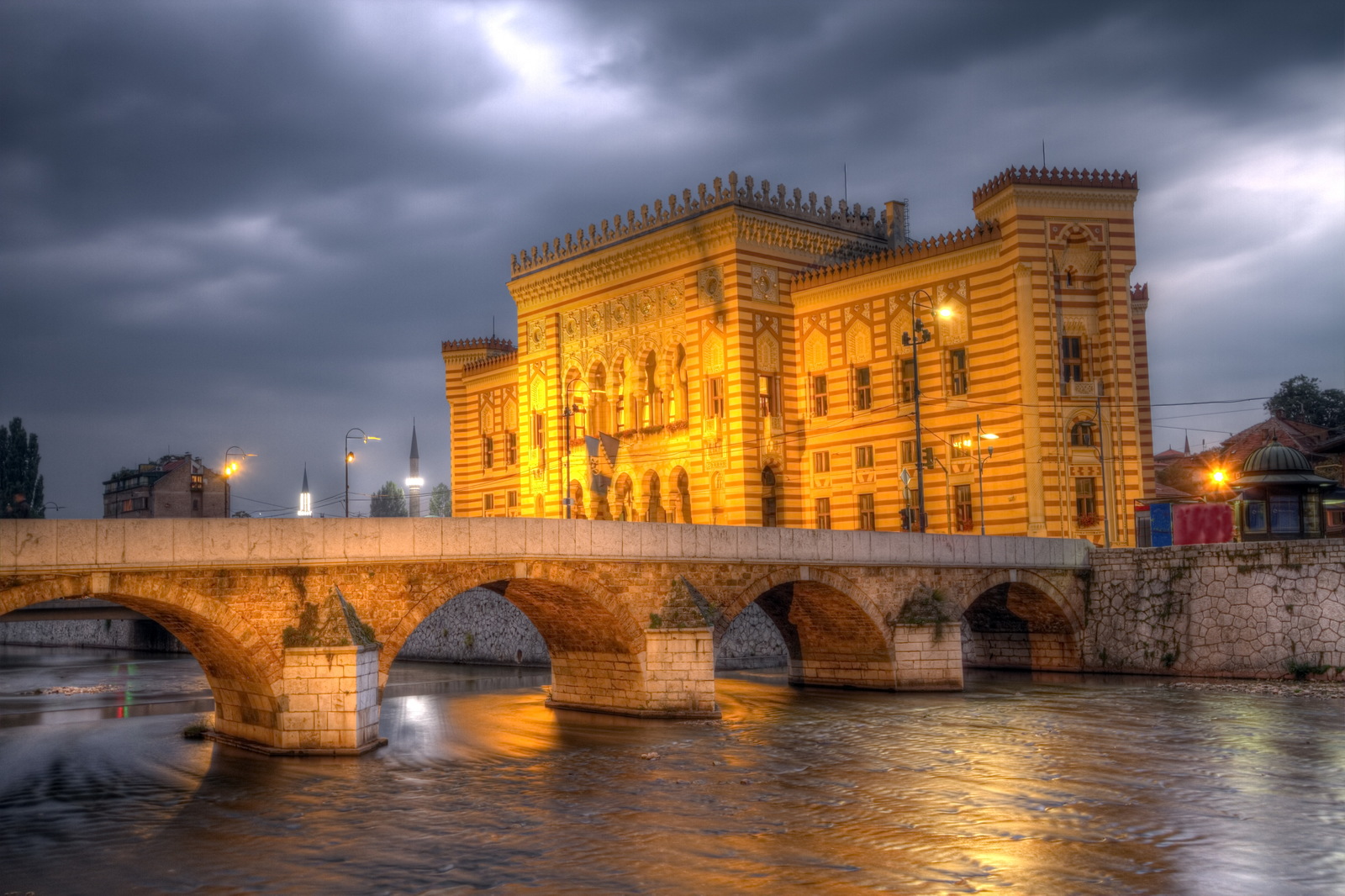
VC5M+H98, Obala Kulina bana, Sarajevo 71000, Bosnia & Herzegovina || every day 9 AM–5 PM
What is it?
The City Hall of Sarajevo is a structure of immense historical importance. Built-in the early 19th century by the Austro-Hungarian Empire, it stands today as a reminder of both the past and present.
Located at the center of Old Town, which is listed on UNESCO’s World Heritage list, City Hall dominates the skyline with its imposing façade and grandeur design. Today, it serves as a hub for local government activity and a meeting point for many important events.
Inside its doors lies an impressive collection of cultural artifacts that span centuries of history in Sarajevo. From ancient weapons to maps to photographs depicting life during wartime, visitors can experience firsthand what makes this city so special to its citizens and the world beyond.
Brief history
Sarajevo’s City Hall is a distinct landmark that has stood in the heart of the city since 1894. The building was designed by architect Kosta Jovanovic, who incorporated elements from several architectural styles of the period including Neo-Renaissance and Moorish Revival.
This combination created a unique exterior that still stands out among nearby structures today.
The building served as Sarajevo’s municipal government office until World War II when it was damaged in the intense bombing campaigns. In the decades following WWII, City Hall underwent extensive rebuilding efforts and reopened its doors in 1971.
Nowadays, visitors can tour its beautiful interior chambers, which have been decorated with intricate details such as ornamental woodwork and stained glass windows.
Visitors can also explore an art gallery and library located on the premises for a more immersive experience.
3 fun facts about the City hall of Sarajevo
- The building was built in 1896 by Viennese architect Alexander Wittek, commissioned by the Austro-Hungarian authorities who occupied the city at the time.
- Today it stands as one of the most recognizable landmarks in Sarajevo, with its neo-Renaissance façade visible from afar.
- As well as being an important administrative centre for local government, it is also home to a museum and exhibition space dedicated to Bosnian history and culture.
The fortress of Sarajevo
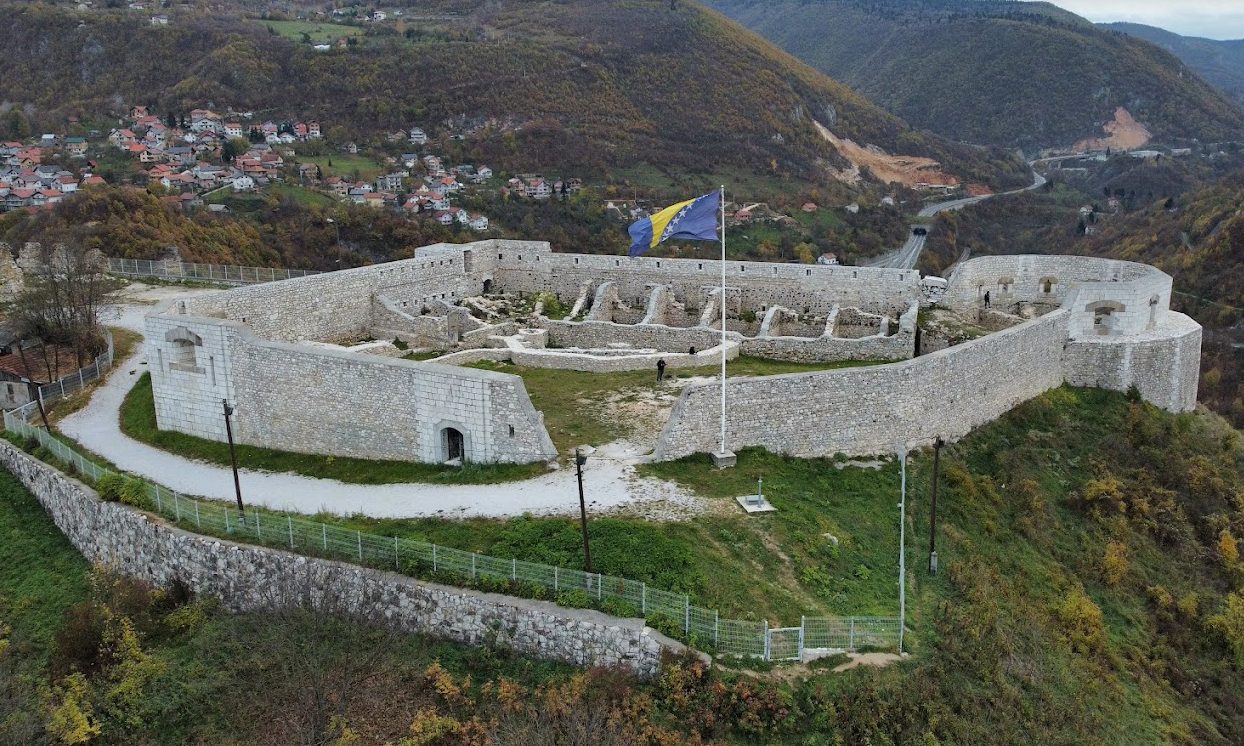
Poddžebhana 15, Sarajevo 71000, Bosnia & Herzegovina
What is it?
The fortress of Sarajevo is a symbol of resilience and strength in the face of struggles. The fortress has been part of many wars over centuries, leaving it with a long and colorful history.
It was first built in the 15th century and served as the city’s defense against attack by foreign forces. The walls were destroyed several times over the course of its history, but they have always been rebuilt with determination.
During the Siege of Sarajevo in 1992-1996, it was once again used as a defensive line against Bosnian Serb forces. Despite heavy shelling from artillery fire and snipers, people still managed to take refuge inside its walls for protection from danger outside.
Today it stands proudly as an iconic landmark that tells tales about this city’s past struggles and hardships that have made it stronger than ever before.
Brief history
The fortress of Sarajevo has a rich history dating back nearly 400 years.
Built in 1582 under the rule of Ottoman Sultan Suleiman the Magnificent, it was originally used as an administrative center for local governance. The fortress also served as a military outpost and protected the city from invasions over centuries by defending its borders.
In addition to its defensive role, the fortress of Sarajevo was also home to many important buildings such as mosques, madrasas (Islamic schools), and hamams (public baths).
Throughout its long history, the fortress underwent several renovations; first by Austrian forces in 1878-1879 and again from 1945-1947 when major repairs were carried out due to damage caused by World War II bombings.
3 fun facts about the Fortress of Sarajevo
- First, the fortress was built during the Ottoman Empire in 1550 as part of a defensive system to protect Sarajevo from outside invasions.
- Later, it was restored by Austro-Hungarians in 1878 to make sure that their rule over Bosnia would be secured.
- In addition, it became an important cultural center for different religions like Islam, Orthodox Christianity, and Judaism which can still be seen today among the remains on display at this site.
Winter Olympics in Sarajevo
The abandoned bob sled track location
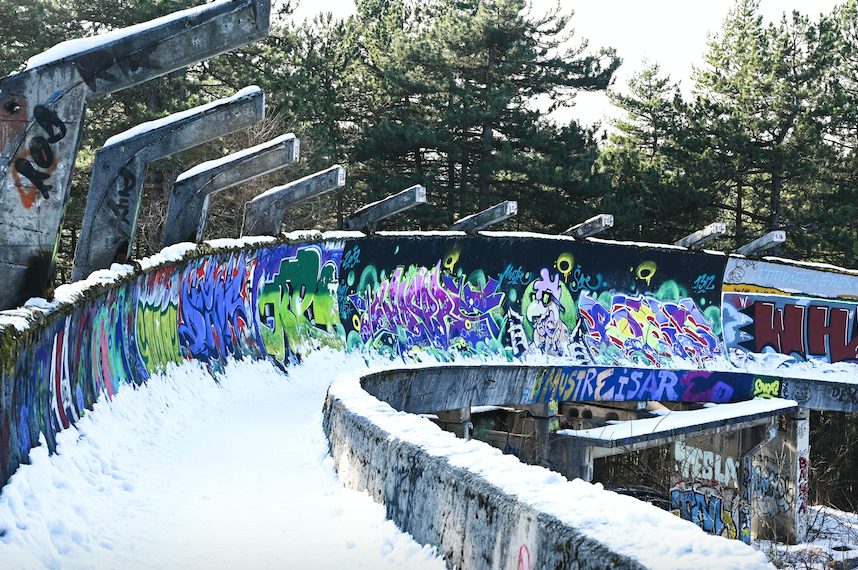
What is it?
When you think of the winter Olympics in Sarajevo, you think of Yugoslavia. But, did you know that the 2030 Winter Olympics are going to be held, again in Sarajevo?
Yes, this is going to be huge for the region! The Winter Olympics are set to make their return to Eastern Europe in 2022 as Sarajevo, has been chosen to host the games.
The announcement was made in relation to celebrations taking place this year for its 150th anniversary since Sarajevo became part of Austria-Hungary. The selection of Sarajevo demonstrates a commitment by the Olympic committee and other organizations to promote stability in Eastern Europe.
Sarajevo is well-known for its stunning natural beauty and numerous historical sites, making it an ideal location for visitors from around the world who come to see all that it has to offer.
Brief history
The history of the Winter Olympics in Sarajevo stretches all the way back to 1984. That year, Sarajevo held the 14th Winter Olympic Games, becoming only the second-ever Eastern European city to host a Winter Olympics.
From athletes from around the world to international media attention, these games were a huge success for Sarajevo and set it on a course of international recognition.
At the time, Sarajevo was part of Yugoslavia, which made its inclusion as an Olympic host all the more significant when taking into consideration that other Iron Curtain countries weren’t allowed to host such events during that era due to Cold War tensions.
3 fun facts about the Winter Olympic games in Sarajevo
- First of all, it was the first time that the Olympic flame burned on free soil after 42 years of occupation by Nazi and Fascist forces before World War II.
- Secondly, it saw athletes from 49 countries competing in 39 events making this one of the largest Winter Olympics ever held at the time. The opening ceremony for these prestigious games was attended by more than 80 000 spectators!
- Another interesting fact is that American speed skater Dan Jansen won his first gold medal here and dedicated his victory to his sister who had passed away earlier that day due to leukemia.
Sarajevo`s Sebilj
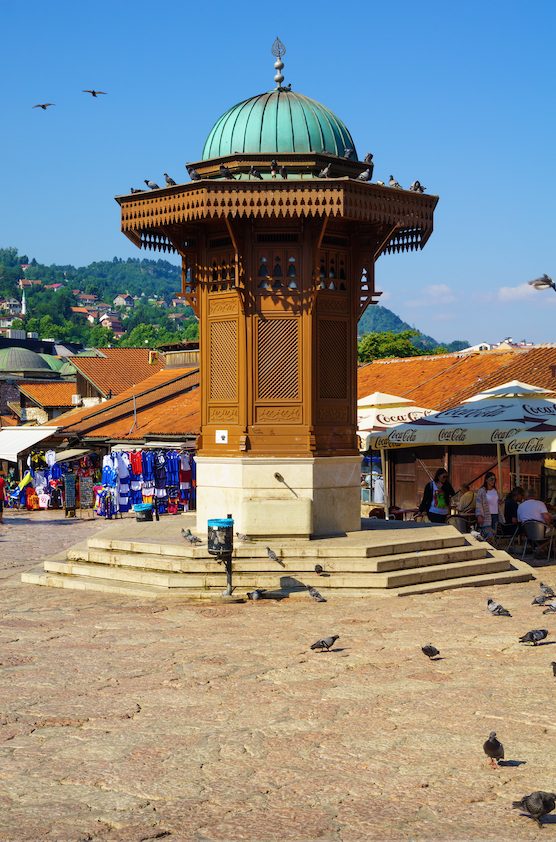
Sarajevo 71000, Bosnia and Herzegovina
What is it?
Sarajevo`s Sebilj is one of the most recognizable symbols of the city of Sarajevo (aren’t they all?). Located in the center of Baščaršija Square, it is a popular place for locals and tourists alike.
This Ottoman-style wooden fountain was built in 1753 by Mehmed Pasha Kukavica and has become an iconic symbol of Sarajevo’s culture and history.
The Sebilj stands today as a reminder of how Sarajevans have endured centuries of war and strife – from Turkish rule to Austrian occupation.
Brief history
This iconic wooden structure has been standing for centuries and has become an integral part of the city’s history. It was originally used as a spot to collect charity donations from passersby.
Since then, it has taken on a more symbolic role as one of Sarajevo’s most recognizable landmarks. The Sebilj symbolizes hospitality towards guests and even serves as an important reminder that all people should be welcomed regardless of their background or culture.
It also stands out for its unique Ottoman-style architecture which can be seen throughout many of Bosnia and Herzegovina’s cities and towns.
3 fun facts about Sarajevo`s Sebilj
- First, the Sebilj fountain is a symbol of multiculturalism.
- It contains elements from both Ottoman Empire and Austro-Hungarian architecture styles.
- There is an old superstition that if you make a wish before throwing coins into the fountain, your wish will come true.
The Cable Car

Hrvatin bb, Sarajevo 71000, Bosnia & Herzegovina || every day 9 AM – 5 PM
What is it?
Sarajevo is one of Europe’s most vibrant and fabled cities, with a plethora of historical and cultural attractions. One of the city’s newest and most popular attractions is the Sarajevo cable car.
The cable car transports visitors from the bustling city center up to Mount Trebević for breathtaking views over Sarajevo. The ride takes just 10 minutes and offers fantastic vistas along the way.
The cable car consists of two cars that can each carry up to eight passengers at a time, offering spectacular 360-degree views as they ascend Mount Trebević.
Brief history
Sarajevo, one of the most vibrant cities in the Balkans, has a unique cable car history. Located at the foot of Mount Trebević, Sarajevo’s iconic cable car was built in 1959 to transport citizens from the city centre up to a ski resort on top of the mountain.
The innovative cable car quickly became an integral part of everyday life in Sarajevo. It provided locals with easy access to Trebević Mountain, which is rich in natural beauty and perfect for hiking and skiing.
Unfortunately, during the Bosnian War that started in 1992, this beloved symbol was destroyed as a result of shelling by forces besieging Sarajevo.
3 fun facts about the Cable car of Sarajevo
- The first cable car opened in 1959 and has been running ever since.
- It was designed to transport people up to the top of Trebević Mountain, which provides an amazing view over Sarajevo from 1,610 meters above sea level.
- The original cars were renovated in 2006 after more than four decades of service. Today, it transports about 300 passengers each hour!
Sarajevo`s Miljacka
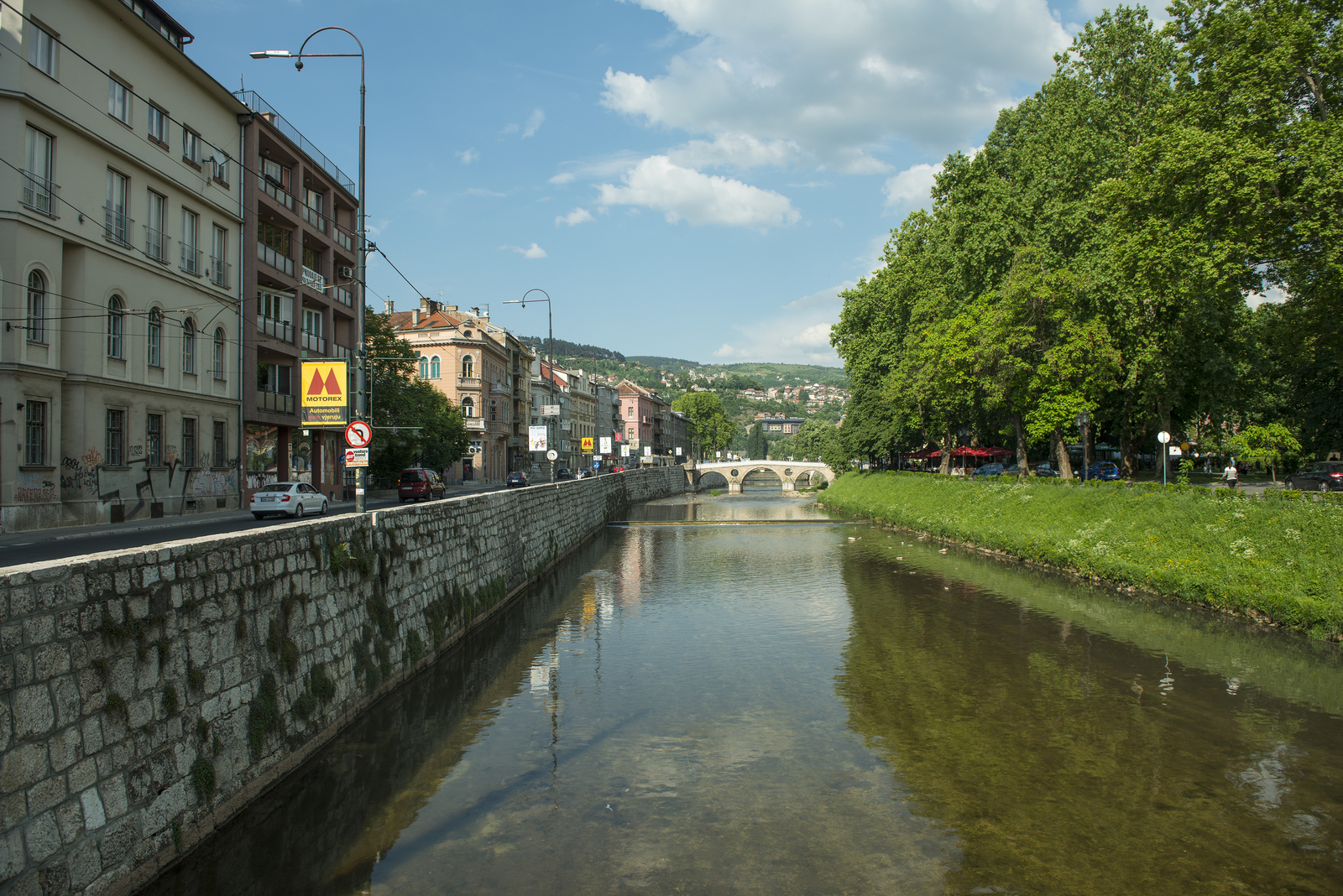
What is it?
Sarajevo’s Miljacka is a river that winds through the heart of the capital. This body of water has been around since before the emergence of Sarajevo, which dates back to 1461 when it was founded by Isa-Beg Ishaković. It is nicknamed the “Little Venice” due to its many bridges, from which locals and tourists alike can admire the views.
The Miljacka River has seen its fair share of history throughout the years. It served as a setting for World War I battles, and in 1914, Archduke Franz Ferdinand was assassinated while crossing one of its bridges.
Brief history
Sarajevo Miljacka is one of the oldest and most historically important rivers in the city of Sarajevo. Connecting two major parts of the city, it has been an integral part of Sarajevo’s history since the 4th century BC.
It is a river that is deeply rooted in Bosnian culture, playing a vital role in its development over the centuries and maintaining significant importance to this day.
The Miljacka River was first mentioned as ‘Bosna’ by Roman Emperor Constantine Porphyrogenitus in his book ‘De Administrando Imperio’, which dates back to 950 AD.
3 fun facts about the Miljacka river
- The Miljacka River is one of Sarajevo’s main sources of fresh water and was first mentioned in historical documents as early as 1445.
- Its total length stretches around 25 km from its source at Mt Jahorina to where it enters the Bosna River near Ilidža.
- During its course, it passes through several residential areas, like Bistrik and Koševo, offering pleasant scenery for locals and visitors alike.
Sarajevo`s Avaz Twist Tower
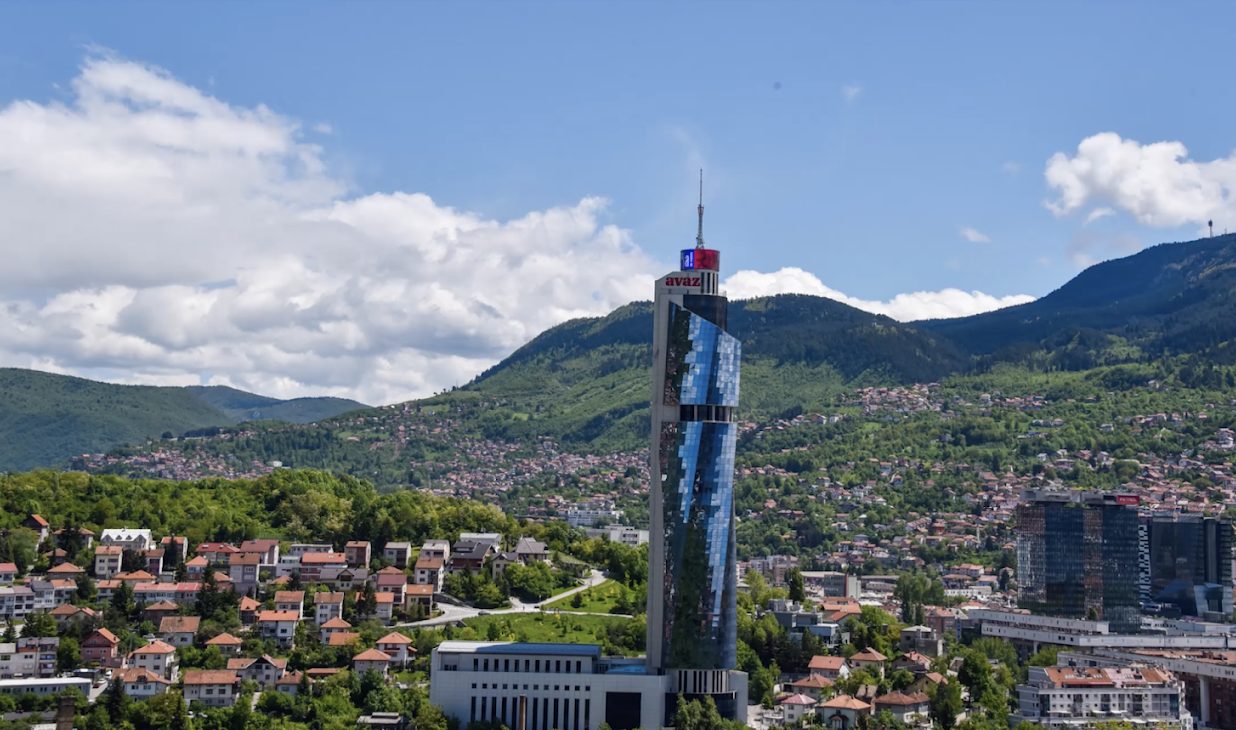
Tešanjska 24A, Sarajevo 71000, Bosnia & Herzegovina || every day 7 AM–11 PM
What is it?
Sarajevo is home to many unique architectural wonders. Among the most impressive is the Avaz Twist Tower. Standing at an impressive 172 meters high, it dominates the city skyline.
Completed in 2008, this unique structure combines traditional Bosnian architecture with modern design elements.
The 12-story tower was designed by Studio Duga and implemented by a consortium of contractors as part of Sarajevo’s revitalization program after suffering destruction during the Bosnian War in 1992-1995.
The building features multiple twisted sections that give it its name; these sections are designed to represent Sarajevo’s cultural heritage and its ability to rise above its troubled past. The top floors contain a hotel offering stunning views over Sarajevo while other areas house office space, apartments, and parking garages.
Brief history
The Avaz Twist Tower located in Sarajevo is a symbol of the city’s unique history and culture. It is one of the tallest buildings in the Balkans and its distinctive twisted shape has made it an iconic landmark.
The tower was designed to reflect the city’s multicultural past by embodying a combination of Ottoman Islamic architecture with modern European design elements.
Built on former minefield land, this striking building commemorates those who lost their lives during the Siege of Sarajevo in 1992-1996. The design itself pays tribute to many aspects of Bosnian culture including its history as part of Yugoslavia before 1991 as well as its turbulent wartime past.
3 fun facts about Sarajevo`s Avaz twist tower
- Standing at 172 meters tall, this iconic structure is the tallest skyscraper in Bosnia and Herzegovina and offers spectacular views of the surrounding area from its observation deck.
- The tower was designed by renowned Bosnian architect Zlatko Ugljen, who created a spiral-shaped design that twists around itself as it rises up into the sky.
- This revolutionary style made it an instant landmark in Sarajevo, with its sleek glass facade making it an impressive sight from anywhere in the city centre.
Sarajevo`s Husrev – beg
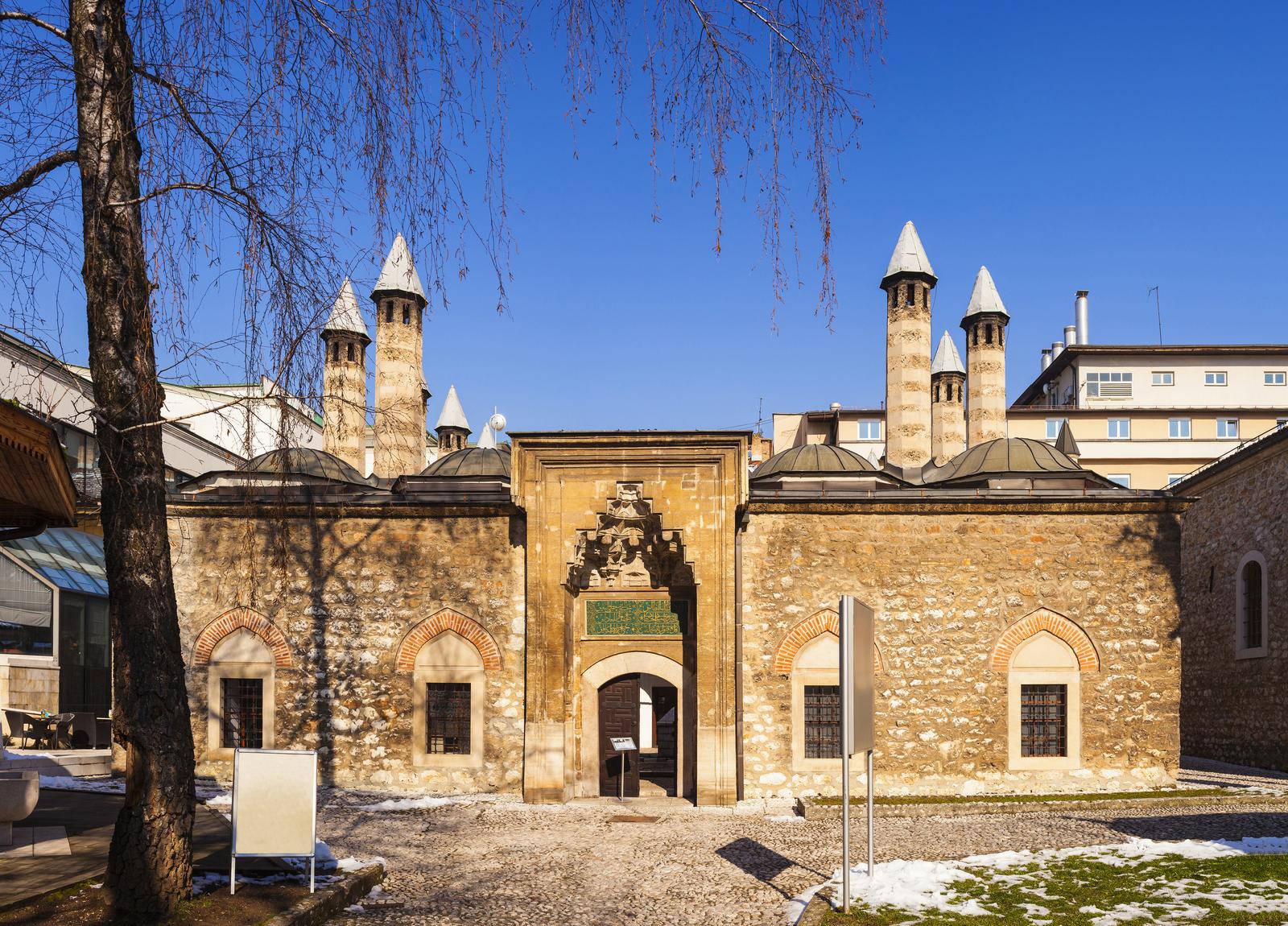
What is it?
Sarajevo is a city with rich history and culture, and one of its most significant landmarks is the Gazi Husrev-Beg Mosque. Built in 1530 by Bosnia’s Ottoman governor, Gazi Husrev-Beg, the mosque stands as an iconic symbol of Sarajevo.
The mosque has been meticulously restored over the centuries, and it remains a vibrant part of both Islamic culture and Bosnian heritage today.
The building itself is grandiose and imposing, with four large minarets that tower over the surrounding area. Inside, visitors can admire elaborate frescoes depicting scenes from the Koran.
The courtyard also houses many tombs honoring local religious leaders including Gazi Husrev-Beg himself.
3 fun facts about Sarajevo`s Husrev – beg
- The mosque was originally built using funds from taxes collected in Bosnia at the time of construction.
- It was considered the largest building project ever undertaken in the Ottoman Empire at that time and required more than 300 workers to build it from scratch.
- A library was also created alongside the mosque and contained over 17000 books during its peak years!
Sarajevo`s Archduke Franz Ferdinand
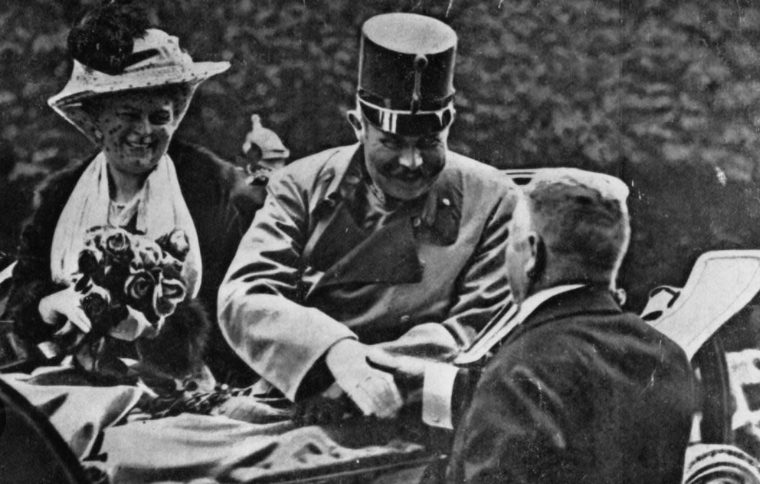
Zelenih beretki 30, Sarajevo 71000, Bosnia & Herzegovina
What is it?
Sarajevo and Archduke Franz Ferdinand have a strong connection in the annals of world history. On June 28, 1914, the Archduke and his wife Sophie were visiting on a state visit to Sarajevo when they were assassinated by Bosnian Serb Gavrilo Princip.
This event is widely accepted as the spark that ignited World War I, making Sarajevo’s link to Archduke Franz Ferdinand one of global significance.
The exact street? Here’s more info about it.
Brief history
Archduke Franz Ferdinand was an influential figure in Austrian-Hungarian politics prior to his assassination. He had long been an advocate for peace between Austria-Hungary and Serbia, hoping to create an atmosphere of mutual understanding and cooperation between the two countries.
Unfortunately, this hope for unity was shattered by the fateful events that occurred in Sarajevo on June 28th, 1914.
Sarajevo is a city steeped in history, and much of its cultural legacy dates back to the days of Archduke Franz Ferdinand.
3 fun facts about Sarajevo`s Archduke Franz Ferdinand
- The assassination happened on June 28, 1914, when Gavrilo Princip fired shots at Franz Ferdinand’s car as it rode through town.
- He was part of a group of six assassins who were all members of the Black Hand secret society.
- The assassination sparked World War I after Austria-Hungary declared war on Serbia two months later due to Serbia’s involvement with the Black Hand organization behind the crime.
Stained Glass Windows in Sarajevo

What is it?
Sarajevo is home to a wide variety of art forms that range from traditional Islamic motifs to contemporary pieces. One such example is the city’s renowned stained glass windows.
These beautiful artworks are found in many of Sarajevo’s historic buildings and offer insight into both its unique culture and history.
Stained glass has long been used as an artistic medium in Sarajevo due to its decorative potential, as well as its ability to provide spiritual symbolism.
The city’s signature style incorporates vibrant colors with intricate geometric patterns inspired by Ottoman architecture and Islamic tradition. Although there have been several attempts at restoration in recent years, these pieces remain a testament to the skillful craftsmanship of generations past.
Brief history
Sarajevo is a city steeped in rich history and culture. One aspect of this is its flourishing stained glass industry, which has been present since the late 19th century.
During this time period, the Austro-Hungarian Empire had great influence in Sarajevo and introduced many European art movements to the area. This included Art Nouveau, a style characterized by intricate floral designs and naturalistic motifs.
Stained glass artists quickly embraced this new design language and developed their own interpretations of it. They used traditional methods to create colorful windows that would adorn many of Sarajevo’s public buildings such as churches, mosques, schools, hospitals, and government offices.
These works were renowned for their vivid colors and complex patterns that could transform any space into something truly magical.
3 fun facts about stained glass in Sarajevo
The city of Sarajevo is home to some of the most beautiful and breathtaking stained glass in Europe.
Firstly, it’s believed that much of the stained glass currently found in Sarajevo was created during the Ottoman era (1463-1878).
During this period, skilled craftsmen from all over Europe were employed by local aristocrats to construct religious and private buildings using their expertise with stained glass.
Sarajevo`s Cobbled Streets
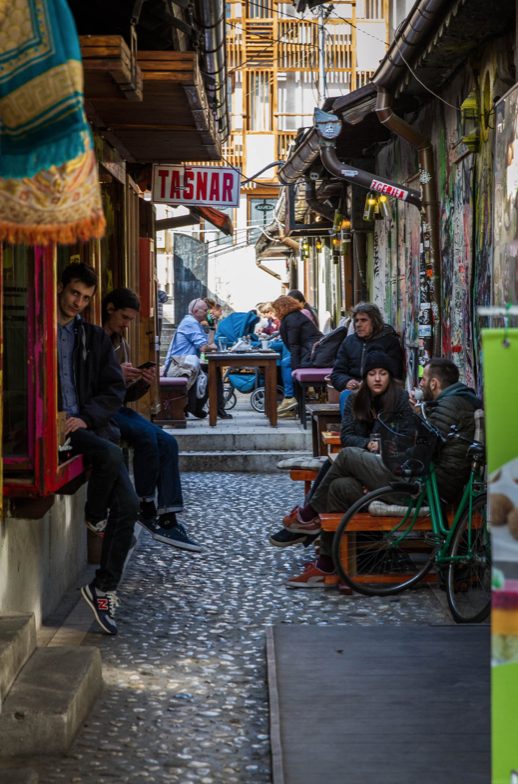
What is it?
Sarajevo’s cobbled streets are a reminder of its long and storied past.
The winding cobblestone lanes have been around since Ottoman times when the city was established in 1462 by Isa-Beg Isakovic. These narrow roads lead to some of the most iconic sights in Sarajevo – including Baščaršija Square, Latin Bridge, and Gazi Husrev Bey Mosque.
The cobblestones also represent Sarajevo’s resilience in overcoming adversity like no other city has seen before or since.
Brief history
Sarajevo’s cobbled streets are a testament to its tumultuous history. The city has been through numerous upheavals since it was founded in 1462 as the Ottoman Empire’s administrative center.
Sarajevo’s cobblestones were laid during this time when builders and craftsmen created astonishingly beautiful mosques, bazaars, and homes across the city.
Since then Sarajevo has endured warring empires and even a siege that lasted for four years from 1992 to 1996. Yet despite all of these terrible events, there is evidence of Sarajevo’s long-enduring spirit throughout its cobbled alleys and plazas.
3 fun facts about Sarajevo`s cobbled streets
- The intricate network of cobbled streets that make up Sarajevo’s old town makes it easy to get lost while exploring.
- One fun fact is that many of these alleyways were deliberately designed to be confusing so that invading forces would find it difficult to navigate!
- Another interesting tidbit is that many of the stones used in paving these paths were taken from local rivers- something which gives these roads an extra special charm.
Siege of Sarajevo
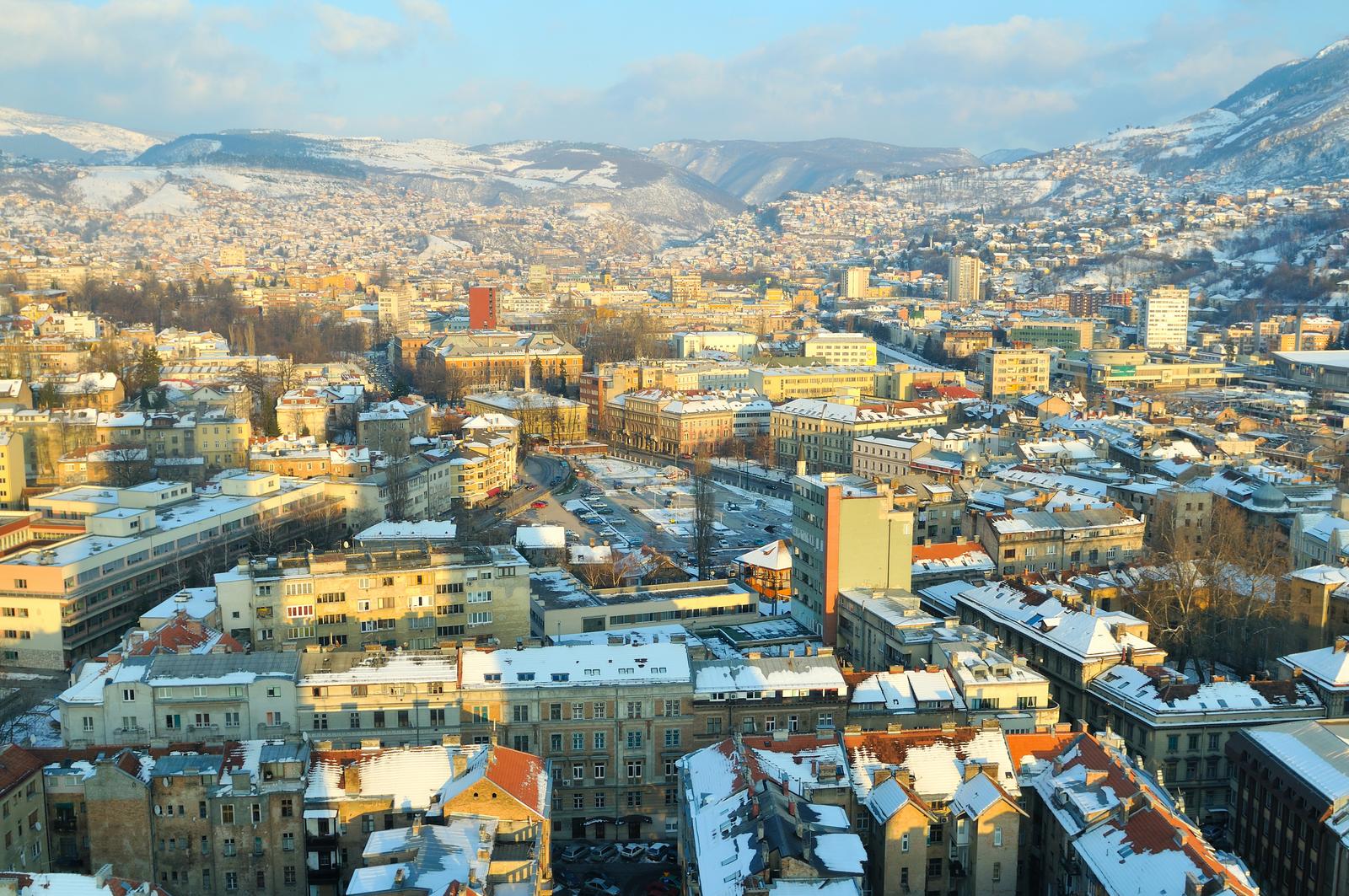
What is it?
This one is not a place, but rather the whole city!
The Siege of Sarajevo was a military engagement that took place from April 5th, 1992 to February 29th, 1996.
It was one of the longest sieges in recorded history and took place during the Bosnian War, which began following the breakup of Yugoslavia. The siege is remembered for its extreme brutality and high levels of civilian casualties.
For nearly four years, Sarajevo was held under siege by Serbian forces.
The citizens were subjected to shelling and sniping on a daily basis while they attempted to go about their daily lives as best they could. Civilians were not spared in this conflict; it’s estimated that over 13,000 people died as a result of the siege including over 1,500 children.
Take this tour here if you want to experience the full 90s war.
2 facts about the Siege of Sarajevo
It was a brutal four-year period for the Bosnian capital city during the Bosnian War that has left a lasting mark on its people and the world.
The city’s main airport, Sarajevo International Airport, became known during this time as “Sniper Alley” due to snipers targeting civilians who were trying to escape via plane.
Three More Things To See & Do In Sarajevo
Sarajevo Tunnel Museum
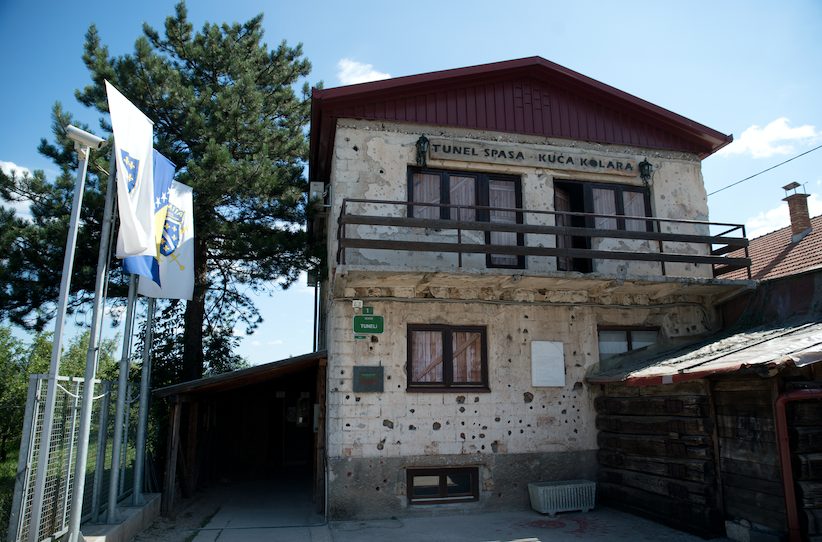
The Sarajevo Tunnel Museum is a unique and historical experience located in the Bosnian capital of Sarajevo. As one of the top attractions in the city, it provides a glimpse into life during the country’s brutal siege.
Built by locals under extremely harsh conditions, the tunnel was an important lifeline for those living through the Siege of Sarajevo. Visitors to this museum can get a first-hand look at what it was like to live through such an event and gain insight into how people survived against all odds.
The museum itself consists of two parts: an exhibition hall where visitors can learn more about the history behind the siege and its social effects, as well as a reconstructed section of the original tunnel that was built during that time.
Book your tour here:
The Yellow Fortress
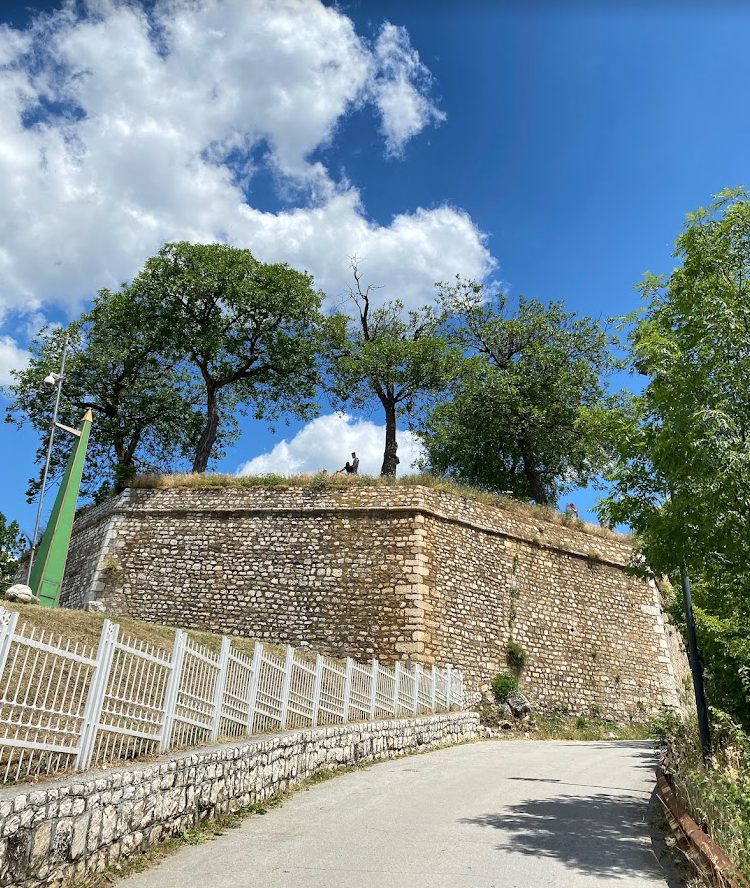
The Yellow Fortress of Sarajevo is one of the most iconic and beloved landmarks in Bosnia and Herzegovina. Located high on a hill overlooking the city, its bright yellow walls have become an integral part of Sarajevo’s identity over centuries.
Once a symbol of protection from invaders, today it stands as a reminder of the city’s turbulent history.
Constructed in 1510 by Gazi Husrev Bey, The Yellow Fortress was originally built to protect Sarajevo from Ottoman invaders. Over time, its walls were strengthened with additional fortifications and towers for defense against enemy forces.
During the Bosnian War in 1992-1995, The Yellow Fortress served as a refuge for civilians seeking safety from shelling. It also became a focal point for media coverage during this conflict due to its prominent location in the city center.
Try The Traditional Kebab
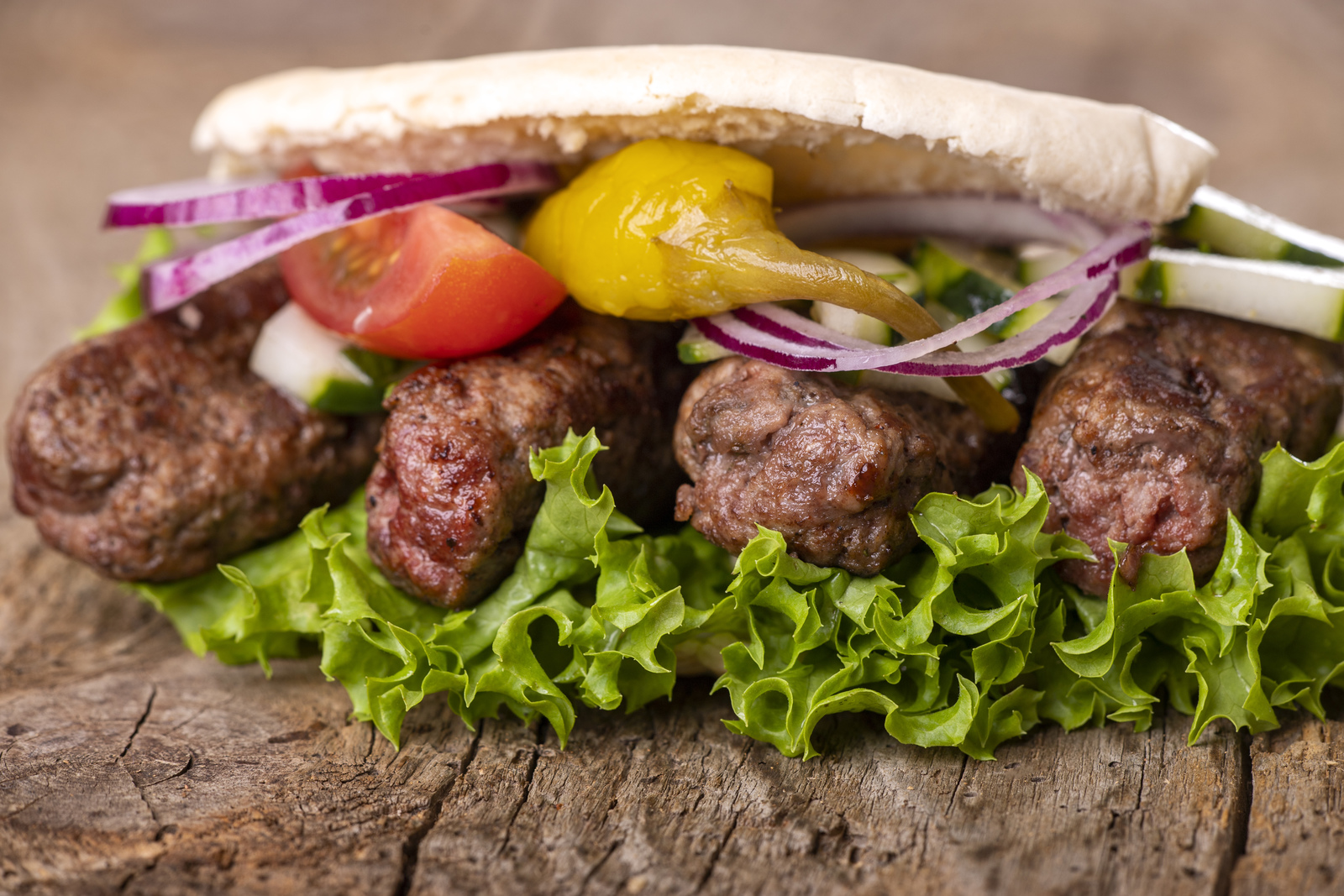
Ok, so If you don’t try the kebab, you haven’t experienced Sarajevo. We’re serious. It’s the most traditional dish you can find – meat kebab, on hot homemade loaf bread with onions and cheese curd.
Like medicine, you’ll either take it once per day every day or don’t come to Sarajevo.
Visitors Also Ask
Is Sarajevo good for tourists?
Sarajevo is an exciting and diverse destination that many tourists consider visiting.
The city has a unique combination of Eastern and Western cultures, spanning a variety of religions, as well as plenty of interesting sights for travelers to explore. But is Sarajevo really worth the visit?
When it comes to finding activities for tourists to enjoy in Sarajevo, there are a multitude of options available. Tourists can take part in cultural events such as the famous Film Festival or enjoy the colorful market stalls along Baščaršija Street.
For those looking to discover more about the city’s history, there are numerous museums and art galleries where visitors can learn about Sarajevo’s past.
Those looking for outdoor activities will be pleased to find that there are several parks and trails located near the city center as well.
Is 1 day enough in Sarajevo?
If you only have one day to explore Sarajevo, can you experience all that this amazing city has to offer? The answer is yes. With careful planning and an eye for detail, it’s possible to make the most of your time in Sarajevo with just one day.
Start early by taking a walking tour around the old city center which will provide insight into its historic sites like the Latin Bridge and Gazi Husrev Bey Mosque.
Then head up to Trebević Mountain for some spectacular views over the city before visiting one of Sarajevo’s many museums or galleries.
How many days are enough for Sarajevo?
The answer depends on what kind of traveler you are and what type of activities you prefer when exploring a new destination. If you are looking for more than just sightseeing in Sarajevo, plan at least three full days in order to get a good feeling for the city’s culture, history and people.
With three days in Sarajevo, visitors can spend an entire day exploring Old Town or enjoying some traditional Bosnian food at one of the local restaurants.
Is Sarajevo worth visiting?
After years of war and strife, this city still remains one of Europe’s most vibrant destinations.
For starters, there are many cultural attractions to explore in Sarajevo. From mosques and churches to museums and art galleries, visitors can gain insight into Bosnia’s rich history through these sites.
What’s more, the city’s nightlife is something that shouldn’t be missed! There are numerous restaurants and bars where you can sample local cuisine or sip on some delicious Bosnian coffee while catching up with friends.
Why is Sarajevo called the Jerusalem of Europe?
Sarajevo, the capital of Bosnia and Herzegovina, is often referred to as “the Jerusalem of Europe” due to its unique religious diversity.
With a history stretching back over 500 years, Sarajevo has long been home to Christians and Muslims alike. The city is known for being one of the few places in Europe where multiple religions coexist peacefully.
This reputation dates back to the 16th century when Emperor Suleiman I conquered Sarajevo and welcomed people of all faiths into his multicultural empire.
Under Ottoman rule, Muslim mosques and churches were built side by side in what became known as “The Jerusalem of Europe”. Even today, many buildings from that era remain standing in Sarajevo showing how the city still retains its diverse culture.
Are There Any Day Trips From Sarajevo?
Best Accommodation In Sarajevo?
When it comes to finding the best accommodation in Sarajevo, there are a plethora of choices. From luxury apartments to budget-friendly guesthouses, this city has something for everyone. So what are the top picks when searching for the best accommodation in Sarajevo?
To start, Hotel Hecco Deluxe offers visitors luxurious amenities and is situated within walking distance of some of the major attractions in downtown Sarajevo. Additionally, their rooftop restaurant boasts an amazing view of the cityscape below.
For those on a tighter budget, Guesthouse Bistrik provides guests with modern rooms equipped with all basic necessities at an affordable rate. Both are excellent options for anyone looking for comfortable lodging during their stay in Sarajevo.
Things To Do In Sarajevo: Conclusion
Sarajevo, the capital of Bosnia and Herzegovina, is a city full of history and culture. Its rich cultural heritage makes it an ideal destination for visitors looking to explore.
Whether you’re looking for outdoor activities or sightseeing opportunities, Sarajevo has something for everyone. From museums and art galleries to hiking trails and parks, there are plenty of things to do in Sarajevo that will keep you busy during your stay.
More Balkan Guides For You!
If you’re traveling to Belgrade, check out our things to do in Belgrade article!
Traveling to Sofia, Bulgaria instead? Here’s an in-depth guide to the best things to do in Sofia!
Or planning on going south to Montenegro? Check the best things to do in Podgorica.
Going north to Zagreb? Check our list for the best things to do in Zagreb.
Maybe even Skopje? Check out our guide on the essential things to do in Skopje!
Last but not least, here’s our guide on the best things to do in Ljubljana!

Hi, I’m Tamara! I`m a freelance translator and love to travel a lot! I like to learn new languages and learn about the customs and traditions of different people worldwide. I enjoy writing about food and traveling. My hobbies include collecting stamps, pictures from around the world, and Christmas cards. I like to read books and walk in nature in my spare time. I like different genres of literature, but I am especially interested in books about food and geography.